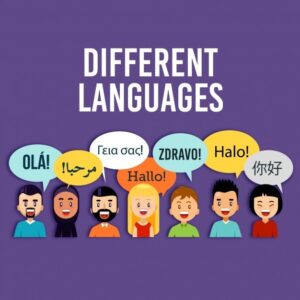Whistling languages, which are fascinating forms of communication developed within various cultures, exemplify the ingenuity of human expression and the role of sound symbolism in language.
This article delves into their rich history, examining the emergence of these unique languages, their geographical significance, and the factors contributing to their decline over time, which is a concern for endangered languages worldwide. It also highlights contemporary revival efforts aimed at preserving these remarkable linguistic traditions, emphasizing the necessity of language preservation and addressing the impact of globalization on cultural heritage.
We invite you to explore the compelling narrative of whistling languages and the ongoing efforts to ensure their survival.
The History of Whistling Languages: An Exploration of Linguistic Anthropology
.jpg_00.jpeg)
Whistling languages, characterized by distinct sound patterns used to convey messages, possess a captivating history that is closely linked to cultural heritage, soundscapes, and the linguistic diversity of various indigenous cultures worldwide.
These unique phonetic systems have developed as a method of auditory communication, particularly in environments where verbal language may be insufficient, thus exemplifying their role in non-verbal communication and social networks. Their origins can be traced to ancient traditions, in which they functioned as essential tools for community interaction and social cohesion, thereby reflecting a profound connection between language, cultural transmission, and social identity.
How and Why Did Whistling Languages Develop? An Insight into Historical Linguistics
Whistling languages have developed as a sophisticated form of acoustic signaling, facilitating effective communication and cross-cultural communication across extensive distances and challenging terrains where traditional verbal language may prove less effective.
These distinctive languages are characterized by their ability to mimic the tonal qualities of spoken words, demonstrating acoustic properties and symbolic representation that can traverse hills and valleys. This quality renders them invaluable in rural or isolated communities, highlighting their role in local customs and folk practices. For example, in regions such as the Canary Islands and certain areas of Turkey, these languages have emerged from the necessity to bridge communication gaps in environments where conventional speech is impeded by distance or physical obstacles.
Whistling languages are not merely practical tools; they serve as embodiments of the cultural identity of their users, reinforcing cultural values and identity preservation. They reflect intricate social practices and deep-rooted traditions that connect generations within their communities.
Where Were Whistling Languages Used? A Study in Sociolinguistics and Environmental Influences
Whistling languages are primarily found in mountainous or rural regions, where communities have historically utilized this distinctive form of communication to effectively navigate their environments and strengthen social connections, maintaining cultural continuity and community resilience.
These extraordinary languages serve not only as practical tools for long-distance communication across challenging terrains but are also intricately interwoven into the cultural identity and cultural significance of various communities.
For example, in Turkey’s Northern Province, the Kuskoy region is renowned for its whistling language, known as ‘duk,’ which local villagers employ to relay messages across valleys, showcasing the performative aspects and linguistic innovation of this communication form. Similarly, specific islands in Greece maintain traditions where whistling functions both as a mode of communication and as a form of artistic expression, particularly evident during local festivities, which are crucial to folk linguistics and cultural festivals.
Regrettably, the encroachment of modernization poses a significant threat to the survival of these languages, necessitating adaptive strategies and conservation efforts. The decline of traditional lifestyles, coupled with the increasing dominance of more widely spoken languages, places immense pressure on these unique modes of communication, rendering them endangered and necessitating urgent preservation efforts, including language documentation and outreach programs.
When Did Whistling Languages Start to Decline? Examining the Impact of Sociocultural Dynamics
The decline of whistling languages commenced in the mid-20th century, as globalization and urbanization transformed traditional lifestyles, resulting in a significant shift in cultural transmission and communication practices, which underscores the role of sociolinguistics and historical linguistics.
As communities transitioned from rural environments to bustling urban centers, the necessity for these unique forms of communication diminished, highlighting the shift in language strategies and narrative traditions. Daily interactions in urban settings predominantly required spoken language, which favored more dominant local dialects and international languages, leading to the gradual obsolescence of once-vibrant whistling languages.
Factors such as migration, where individuals relocated from their native villages in search of improved opportunities, further exacerbated this trend, contributing to language extinction and the erosion of oral traditions. Additionally, the advent of mass media and technological advancements introduced newer, more efficient means of communication that overshadowed these traditional practices, thereby reducing their relevance in the rapidly evolving modern world and illustrating the impact of technology on language policies.
The Decline of Whistling Languages: Challenges in Identity Expression and Cultural Revival
The decline of whistling languages presents a considerable threat to the cultural identity and multilingualism of the communities that employ them.
This phenomenon reflects broader trends in language loss and highlights the challenges encountered by endangered languages globally, emphasizing the need for community support and identity expression.
What Factors Contributed to the Decline of Whistling Languages? Insights into Sociolinguistic Change
.jpg_01.jpeg)
Several factors have contributed to the decline of whistling languages, including the rapid pace of globalization, urbanization, and a shift in communication practices that prioritize dominant languages over indigenous forms, which are explored in academic research and linguistic anthropology.
As communities become increasingly interconnected through technology and travel, traditional modes of communication, such as whistling languages, are often overshadowed by more widely spoken dialects, necessitating language revitalization and conservation efforts. In urban environments, the cultural landscape tends to be simplified, with younger generations gravitating toward mainstream communication methods that lack the richness and nuances of their ancestral tongues, posing a challenge for heritage preservation and intergenerational transmission.
In response to this trend, various grassroots initiatives and community workshops are emerging. Local organizations are mobilizing to document these unique languages, educate their communities about their cultural significance, and integrate whistling languages into arts and educational programs, fostering public awareness and promotion initiatives. These efforts aim to foster renewed interest and appreciation among younger populations, encouraging youth involvement and language teaching.
What Languages Have Lost Their Whistling Variants? Examining the Effects of Language Extinction
Numerous languages have experienced the loss of their whistling variants due to the detrimental effects of language decline and the decreasing use of traditional communication methods in contemporary societies, reflecting linguistic heritage and sociocultural dynamics.
For example, the whistled speech used by the indigenous people of the Canary Islands, known as Silbo Gomero, exemplifies how linguistic features can offer unique means of interaction with both the environment and one another, highlighting its role in heritage languages and performative aspects. Similarly, the whistling language present in certain communities along the Black Sea, which enabled long-distance communication across hilly terrain, has witnessed a decline as younger generations increasingly adopt dominant spoken languages, illustrating the challenges of adaptive strategies and cultural revival.
The loss of these whistling variants represents more than just the absence of sound; it indicates a disruption in cultural transmission and poses a threat to the rich tapestry of linguistic diversity and social change. Preserving such forms of communication is essential, not only for safeguarding linguistic heritage but also for nurturing a sense of identity and belonging within these communities, promoting cultural revival and community engagement.
Revival Efforts for Whistling Languages: Strategies for Language Revitalization and Cultural Continuity
Efforts to revive whistling languages have increased in recent years, propelled by a heightened awareness of their cultural heritage significance and the necessity for linguistic revitalization to address the ongoing trends of language loss, emphasizing the importance of community resilience and learning environments.
What Are Some Current Revival Efforts for Whistling Languages? Exploring Language Strategies and Promotion Initiatives
Current revival efforts for whistling languages encompass educational programs aimed at teaching younger generations the art of whistling communication, alongside community engagement initiatives through cultural festivals and workshops, highlighting the role of educational initiatives and cultural revival.
These programs typically incorporate hands-on experiences, enabling participants to learn not only the techniques of whistling but also the rich cultural history associated with these distinctive forms of communication, promoting listening skills and creativity.
Along with educational initiatives, various local organizations actively implement community engagement strategies, which include immersive events such as traditional storytelling evenings featuring performances of whistled songs, fostering community involvement and narrative traditions.
Festivals that celebrate cultural heritage often host competitions and demonstrations designed to attract audiences of all ages, thereby inspiring a renewed interest in linguistic diversity and symbolic representation.
These multifaceted approaches not only strive to preserve whistling languages but also promote an appreciation for the intricate ways in which human expression can manifest, contributing to heritage sites and public awareness.
How Successful Have These Revival Efforts Been? Analyzing Community Support and Identity Preservation
The success of revival efforts for whistling languages has been varied, with certain communities experiencing a notable resurgence in interest and practice, while others continue to face significant challenges related to language loss, reflecting the role of language documentation and cultural values.
This dichotomy underscores the complex dynamics at play, as diverse community initiatives often encounter varying levels of acceptance and support, emphasizing the importance of community resilience and social cohesion. In regions where local traditions are actively celebrated and promoted, there is generally a stronger propensity for revitalization, highlighting the impact of community workshops and cultural festivals. In contrast, areas grappling with socio-economic difficulties, urbanization, or insufficient institutional support frequently find themselves at a disadvantage, illustrating the need for adaptive strategies and outreach programs.
Several factors, including educational programs, cultural events, and intergenerational transmission, can profoundly impact these initiatives, underscoring the significance of language competitions and academic research. Community engagement, collaboration with linguists, and the presence of committed advocates are essential components that contribute to both the successes and challenges of preserving these unique forms of communication, promoting cultural significance and sociocultural dynamics.
The Importance of Preserving Whistling Languages: A Call for Language Preservation and Cultural Values
.jpg_10.jpeg)
The preservation of whistling languages is essential for safeguarding cultural heritage and promoting linguistic diversity, reinforcing identity expression and social change.
These distinctive forms of communication serve as a reflection of the identity and traditions of the communities that utilize them.
Why Is It Important to Preserve Whistling Languages as Part of Cultural Heritage?
Preserving whistling languages is essential for recognizing the cultural significance they possess, as these languages embody unique community histories and facilitate the preservation of identity and cultural heritage for future generations. This ensures the continuity of traditional practices and maintains linguistic diversity in an ever-changing world.
These intricate forms of communication, a prime example of acoustic communication, typically developed in isolated regions, enabling interaction across considerable distances while reflecting the cultural nuances of their speakers. The oral traditions embedded within these whistled dialects not only mirror the environment and social structures of the communities but also reinforce their distinct identities and cultural transmission in an increasingly globalized world.
Community-driven initiatives aimed at revitalizing and teaching these languages can play a crucial role in ensuring that future generations appreciate their heritage and continue to uphold the cultural values these languages represent. Such efforts are vital components of language revitalization and conservation efforts.
By creating an environment where these unique forms of expression are acknowledged and celebrated, communities can maintain a sense of cultural continuity and belonging, thus reinforcing their rich cultural tapestry and ensuring social cohesion.
What Can Be Done to Preserve Whistling Languages and Prevent Language Extinction?
To effectively preserve whistling languages and prevent language extinction, it is essential to employ a combination of community initiatives, educational programs, and language documentation efforts aimed at engaging younger generations and raising awareness of their cultural significance. These strategies support language preservation and heritage preservation efforts.
Local organizations can facilitate community workshops in which community members and elders impart the art of whistling languages to children, thereby making the learning process both enjoyable and interactive. Integrating these unique forms of communication into school curricula can foster appreciation and understanding, ensuring the intergenerational transmission of these languages to future generations and promoting community engagement.
Moreover, activist organizations can play a crucial role by organizing campaigns that emphasize the importance of linguistic diversity, attracting funding for preservation projects, and collaborating with academics to develop comprehensive language documentation. This collaboration is crucial for promoting public awareness and adaptive strategies in linguistic anthropology.
Collectively, these efforts give the power to communities, fostering a vibrant environment in which whistling languages can thrive and continue to contribute to cultural identity and social change. Such initiatives are key to cultural revival and identity preservation.
Frequently Asked Questions
1. What are whistling languages and why are they declining?
Whistling languages are unique forms of communication that use whistling sounds to convey messages. They are declining due to the spread of modern technology and easier means of communication, such as cell phones and the internet.
2. How many whistling languages are currently in danger of disappearing?
.jpg_11.jpeg)
There are approximately 30 whistling languages in danger of disappearing, with some being spoken by less than 50 people.
3. What are some revival efforts being made to revive whistling languages?
There are various organizations and initiatives, including conservation efforts, working towards the preservation and revival of whistling languages, such as the International Association of Whistlers and the Linguistic Society of America’s Special Interest Group on Whistled Languages. These efforts emphasize the importance of cultural transmission and identity expression.
4. Can whistling languages be adapted for modern use amidst globalization?
Yes, some efforts are being made to adapt whistling languages for modern use amidst globalization, such as creating written versions or incorporating them into music and performances. These adaptations highlight the potential for linguistic innovation and performative aspects in contemporary contexts.
5. Is there still a need for whistling languages in today’s society despite the technology impact?
While the need for whistling languages as a means of everyday communication has diminished due to the technology impact, they still hold cultural and historical significance for the communities that use them. These languages are integral to maintaining folk linguistics and historical linguistics within indigenous cultures and rural communities.
6. How can individuals support the revival efforts of whistling languages through community support?
Individuals can support the revival efforts through community support by learning about and spreading awareness of whistling languages, supporting organizations and initiatives, and visiting communities where whistling languages are still in use. Engaging in cultural festivals and community resilience initiatives can also promote cultural significance and narrative traditions.

My name is Bruno, I have been a writer for 5 years and I work with website creation. My goal is to provide true information to readers. In fact, on this site I write about cultures and traditions, which I have been passionate about since childhood.




